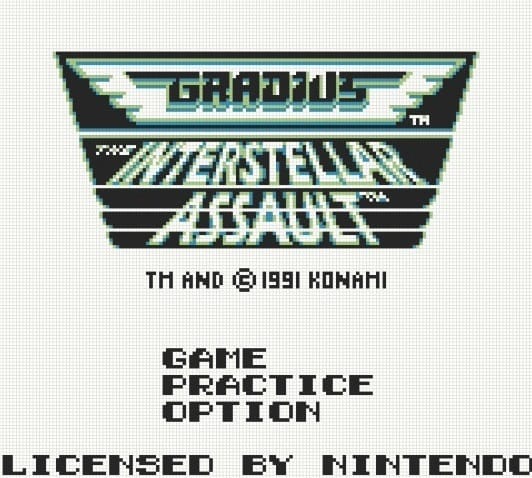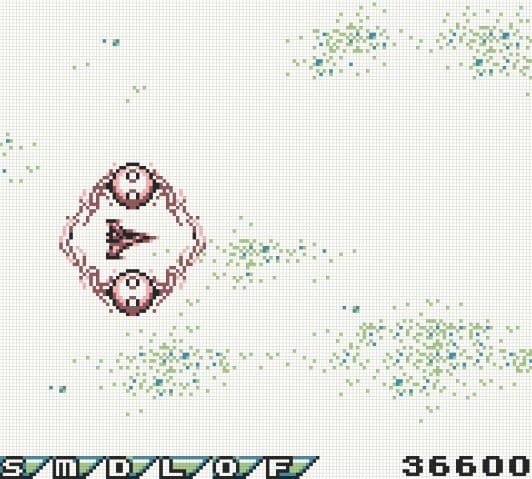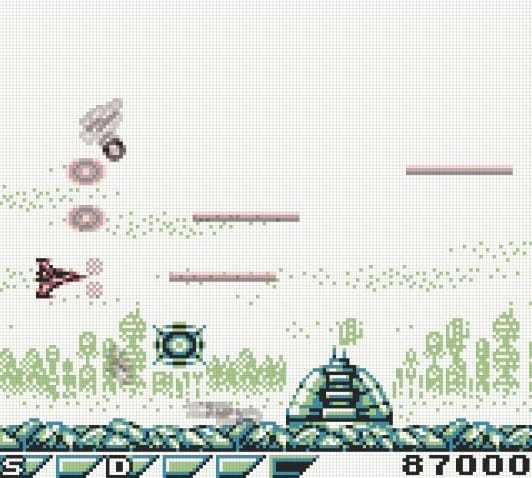- Retro XP
- Posts
- Retro spotlight: Gradius: The Interstellar Assault
Retro spotlight: Gradius: The Interstellar Assault
Unlike Gradius' first Game Boy outing, there is a whole new game here.
This column is “Retro spotlight,” which exists mostly so I can write about whatever game I feel like even if it doesn’t fit into one of the other topics you find in this newsletter. Previous entries in this series can be found through this link.
Gradius games have a habit — and this is not a criticism — of doing the same sort of stuff constantly, with callbacks big and small and the kinds of gameplay and design elements that you’ve seen a bunch of times before showing up anew. It’s not to say that they are often rehashes, but there is an expectation of the kinds of levels you’ll face, or some of the enemy types, or the overarching structure of a given stage will be pretty set in stone, with the first half being a segment for powering up and the second being focused on the actual unique challenge of the thing.
This concept was so strong in these games in general that part of the success of Gradius Gaiden was the tweaking of this known setup to play on expectations and delight with little surprises here and there. It’s just how Gradius games are; fans came to expect it. And it also made the release of Nemesis on the Game Boy ripe for the kind of design that plenty of portable versions of arcade and console series had already gone with, which is to say that you could have slapped a “made out of 100% recycled materials” sticker on the box. Just like the Mega Man games on the Game Boy were made up of basically bits and pieces of the NES games stitched together, Nemesis was elements, stages, and music from various Gradius titles that preceded it. Nothing wrong with that, as the idea was “here’s Gradius, but portable,” and that was a novel concept at the time. But there was room for something wholly original, if Konami wanted to go that route.
Which is where Gradius: The Interstellar Assault comes in. It’s not only original material from the ground up, but it’s fairly different from Gradius in general in terms of design. You have the same basic setup, with some slight weapon customization to choose from before you begin, in terms of what kind of missiles, double shot, and laser you’ll have available, and the power-up bar works the same way it always does in the Gradius — not Salamander — titles, with the RPG-inspired character build equivalent for an STG in place, that allows you to prioritize specific weapon types, ship speed, options, or even shields. You’ll see some recognizable foes — there is, of course, a ship with a core, and you have to shoot it — but otherwise this takes on an approach to level design and level continuity that is unlike any Gradius that had come before it. It’s surprising to see in a Game Boy title, even, but given the limitations of the platform, this uniqueness was likely because it was on the Game Boy more than anything — it was a way to stand out both for the series and on the platform.

The Interstellar Assault even starts out different, out of the gate: an unseen enemy destroys the capital ships flanking your comparatively tiny fighter, the Vic Viper, and then starts chasing you. You aren’t destroying a bunch of enemy ships in this section, but flying for your life, navigating, eventually, a series of caverns that you hope will allow you to escape this enormous vessel that is crashing straight on through some of this rock like it’s nothing.
It turns out that this is the first “transition” to a stage — you will escape that ship, and then play Gradius like “normal” after that — and that The Interstellar Assault is loaded with those, and they’re all wildly different. After you complete the first stage and are feeling sufficiently powered up, you begin to head to the second one like you normally would in a Gradius title, and then whoops, you’re caught in some kind of tractor beam. One that also wiped out all of your upgrades as if you just died. You’re brought inside the massive ship, powerless, and have to fight your way out from in there while powering your ship back up with the upgrades found inside.
The other transition elements are more visual than anything, unlike the first two in which at least part of the stage is built around them, but they’re impressive, and basically Konami showing off what they and this 8-bit, monochrome system are capable of. The best of the bunch comes after you fight the one recognizable enemy from the series’ past — you know, where you shoot the core. Check out this transition, where, as it becomes clear that you’ve defeated the monstrosity, it begins to fall from orbit, so you begin to descend in the Vic Viper as well, until you end up on the surface of a planet to continue your assault.
Look at the flames signifying reentry into the planet’s atmosphere on the Vic Viper! The stars giving way to clouds! The slow disintegration of your helpless foe, which was too weak from battle to protect itself and broke up in the atmosphere as you continued to descend! Konami didn’t need to make that kind of transition on the Game Boy — they could have easily faded to black, or just had you continue forward after the ship exploded, but they went all out here to create something memorable despite the system’s graphical limitations.
These segments stand out even more when you realize that The Interstellar Assault is limited to just two options to accompany the Vic Viper — too many shots and sprites on screen would likely hamper performance or drop it to zero, same as with the NES ports of Gradius games — and the ship itself doesn’t animate when it moves. Konami decided to find other ways to make it all look sick as hell, as the platform allowed, and they succeeded.

Trapped!
The Interstellar Assault is a short game, at just five stages, and it’s not particularly difficult as far as Gradius games go. The emphasis seemed to be on making this portable in every possible way — a pick up and play entry, where you could complete a run in the time it took your parents to drive you from Point A to Point B, or while you were sitting around somewhere just hoping to waste 20 minutes. That’s not to say it won’t challenge you whatsoever — it is Gradius — but if you can dodge and avoid running into walls in the process, you should be able to stay powered up for the most part throughout, and clear it with relative ease.
While it was known as Gradius: The Interstellar Assault at release in North America, it was Nemesis II in Japan, and Nemesis II: The Return of Hero in Europe. Possibly the most Gradius thing about The Interstellar Assault is a naming convention that no one can agree on depending on where you live, that makes little sense to everyone for different reasons. And it gets more confusing later on, too: in 1997 and 1998, Konami would release a bunch of their Game Boy games in compilations designed for the Super Game Boy and Game Boy Color, first in Japan but then in Europe a few years later. The Interstellar Assault was one of the included titles — as was Nemesis — but they were renamed. Nemesis became Gradius, and Gradius: The Interstellar Assault became Gradius II, with its European title appending “The Return of the Hero” as a subtitle. There was already a Gradius, obviously, and there was already a Gradius II and a Gradius 2, but that didn’t stop Konami. Nothing can stop Konami from further complicating the naming scheme of Gradius when given the opportunity.

Missiles, options, and lasers, oh my.
Hell, they’re still at it: the Gradius Origins collection, released in 2025, had one new game in it, Salamander III, which kills me to type since its predecessor is styled Salamander 2. Just make up your mind, Konami!
Gradius: The Interstellar Assault was re-released on the Game Boy portal of Nintendo Switch Online, with the option to play it with its Game Boy Color/Super Game Boy appearance — seen in these screenshots and video, which you probably guessed given that it didn’t have that monochrome appearance to it, even if it’s not full of bright colors like Gradius typically is. Nemesis is not there with it, but if Konami was just going to release one of these Game Boy Gradius titles, then they made the right call: there’s nothing wrong with Nemesis, as said, but it’s just unexciting, as it’s Gradius but watered down a bit for the platform not just visually, but in its scope and gameplay, too.
The Interstellar Assault couldn’t be Gradius exactly as it was known on more powerful platforms, so instead, like with the ports of various Gradius titles to the 8-bit NES, Konami tried to figure out how to make it work for the Game Boy without compromising it, turning it into its own thing. Since this was an original effort and not a port, they could lean into further into it, which is why there is such emphasis on these transitional stages and unique gameplay experiences, such as the opening chase scene where you’re outrunning a massive enemy vessel and dodging asteroids. The Interstellar Assault might not be an essential addition to the Gradius canon in the way some other non-arcade originals ended up being, but it’s still a worthwhile experience that won’t take veterans of the series very long to figure out and complete.
If nothing else, just check out that reentry sequence again — it’s truly sick work for the intentionally underpowered Game Boy.
This newsletter is free for anyone to read, but if you’d like to support my ability to continue writing, you can become a Patreon supporter, or donate to my Ko-fi to fund future game coverage at Retro XP.